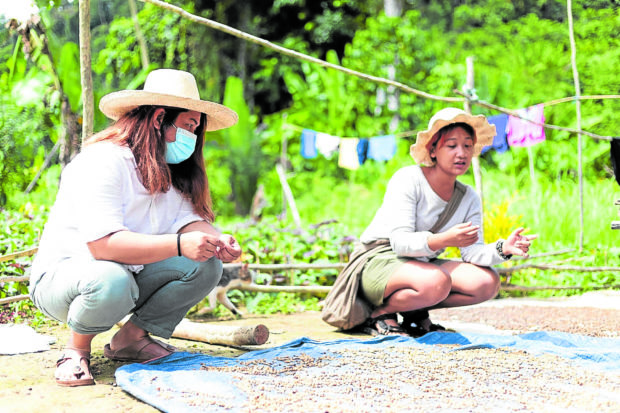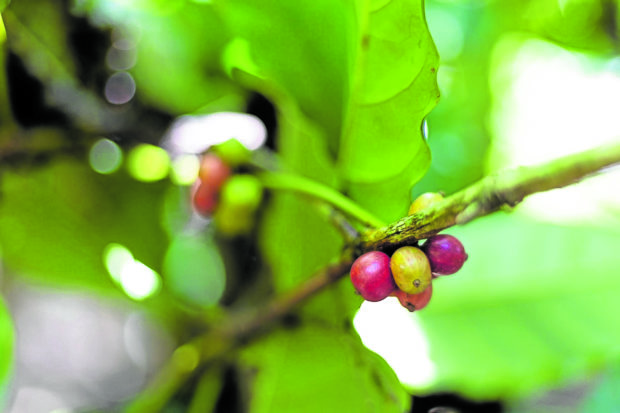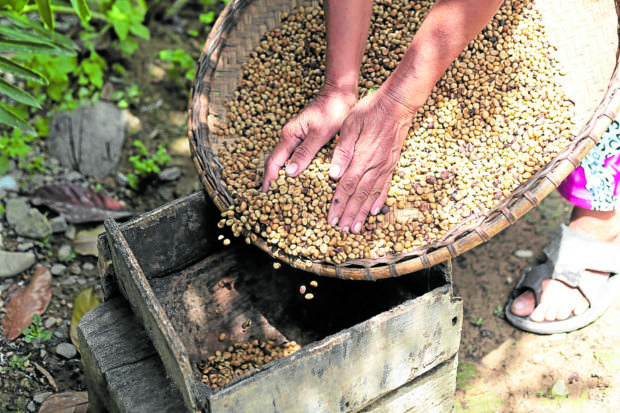Coffee time in Palawan

MANUAL PRODUCTION Coffee beans harvested from the family-run Palay Farm in the village of Maoyon in Puerto Princesa City are processed by hand, sun-dried and refined using “lusong” (large wooden mortar and pestle). —PHOTO COURTESY OF ARIS LEOVEN
PUERTO PRINCESA CITY, Palawan, Philippines —Unspoiled beaches, turquoise waters, lush forests, diverse wildlife, fresh seafood and nature at its best.
While Palawan province ticks all of these, homegrown coffee is nowhere near the top of this list that the Philippines’ last frontier is known for.
This, however, did not stop local coffee connoisseurs from pursuing a “crop to cup” production system, determined to put the island province on the map of the country’s coffee industry.
“People don’t know that there are coffee farms here, that is why [local coffee] is not being marketed properly,” said Carissa Olit, 27, co-owner of Scool, a small coffee shop at the center of Puerto Princesa’s commercial district.
Sourcing coffee beans locally, she said, would benefit farmers in the long run.
Article continues after this advertisement“The problem is with the demand. If farmers don’t see the potential value, they would opt to plant different crops. If they see its worth, it may encourage others to plant coffee,” said Olit, who has been in the coffee business for more than three years now.
Article continues after this advertisementPhilippine Statistics Authority data in 2015 showed that the Mimaropa (Mindoro, Marinduque, Romblon and Palawan) region ranked only 13th out of the country’s 16 regions in terms of the number of coffee trees.
In 2019, the Philippines produced 62,062 metric tons of green coffee beans but consumed around 100,000 MT of coffee, importing nearly half of the demand from the United States, Japan, Brazil and the European Union, according to a 2020 report of the Philippine Coffee Board Inc., a private sector-led group formed to improve coffee output.

FROM CROP TO CUP In Palawan’s coffee plantations, the choicest cherries are picked to produce a homegrown brew that is aimed at sustaining the livelihood of local farmers and indigenous peoples communities and help put the province on the Philippines’ map of coffee-producing areas. (Photo courtesy of Aris Leoven)
Livelihood opportunity
Silvester Dan Samonte, 38, owner of LICK (Lost Islands Center for Kape) in El Nido town and the 2016 Philippine National Barista champion, has started a sustainable livelihood project for the indigenous peoples community of Tagbanua in the village of Napsan, a coastal community in northwest of Puerto Princesa, approximately 39 kilometers from the city center.
He said the soil and climate in Napsan were good for coffee growing.
“We just started in Napsan to plan and work in their forest. This year we will be setting up different variations of the lowland fruit forest with the Tagbanua tribe through the Byanyas (a subgroup of the tribe). We will work hand in hand [and see] the whole process [through]—from seed material to growing and processing. We are trying to design a sustainable livelihood which protects and enlivens the forest,” Samonte said.
Palawan coffee beans, he said, have a distinct flavor and aroma that made it different from other coffee variants in the country.
Olit agreed, who said local coffee beans were full-bodied, nutty, with a hint of sweetness and less acidic when compared to other locally grown beans from Sagada in Mountain Province or Batangas province.
“It is perfect for milk-based drinks because of its flavor,” she said.
Samonte said the lowland Robusta and Liberica coffee beans produced in Palawan showed great marketability potential.
“I’ve tasted quite a few nice ones and all show so much promise to be very tasty. The soil and climate is good for coffee growing. [We] featured one (60-kilogram sack) last year, it sold out quickly,” Samonte added.
He is hoping to get more coffee from southern Palawan during the next harvest from September to October.

(Photo courtesy of Aris Leoven)
Single-origin
Further north of Puerto Princesa, in the village of Maoyon known for its wild river cruise rafting, hidden beneath the westernmost part of the waterway stands Palay Farm, a family-run enterprise that once supplied a multinational coffee company.
Palay Farm’s coffee beans, harvested from more than 2 hectares of land, are proudly single-origin coffee, or those grown within a single known geographic region.
It takes about 40 minutes by boat through the Maoyon River to reach the coffee plantation where farmers, mostly close relatives of the family that run the farm, harvest lowland Robusta coffee cherries.
Robusta cherries mature after 10 months. Beans are sun-dried in the farm before these are processed traditionally, using a “lusong,” or a huge wooden mortar and pestle.
Unroasted beans usually sell for P250 a kilo in some coffee shops in the city, where these are roasted.
Logistics is a challenge, Olit said, as the processing takes place in several parts of the city.

(Photo courtesy of Aris Leoven)
Rewarding
In the southern Palawan town of Bataraza, Nickel Asia Corp., a subsidiary of Rio Tuba Nickel Mining Corp. (RTN), produced 1.7 tons of harvested coffee cherries during the harvest period from October to March.
The company supervised about 200 ha of a coffee plantation in Bataraza, the largest of which is a 48-ha farm at Sitio Racub in the village of Rio Tuba that is planted with over 48,000 Liberica coffee trees.
According to Jose Roberto Serrato, vice chair of Sandoval Farmers Producers Cooperative who owns 4,000 coffee trees in a 4-ha land in the village of Sandoval, RTN is buying his farm’s harvests since he has yet to find a regular buyer.
Serrato said having a coffee plantation had been financially beneficial. However, coffee trees, like most plants, also need a lot of attention.
“For now, it is tedious. But in the long term, farmers would see the benefit and realize that locally sourced coffee would improve their livelihood, the quality of their lives,” Olit added.